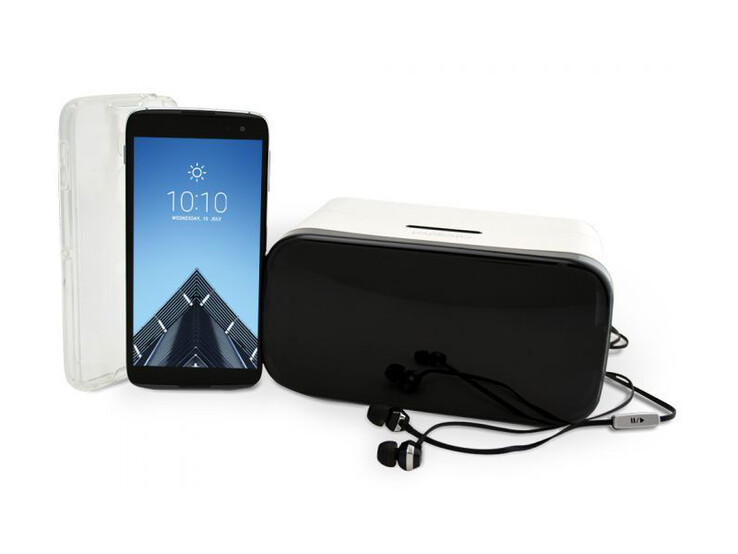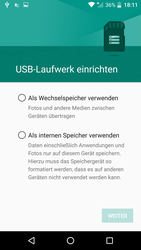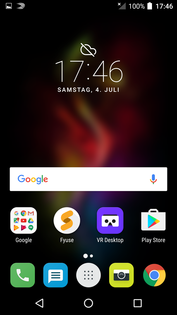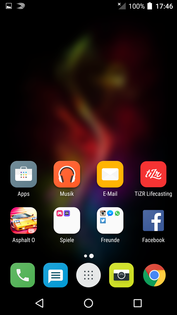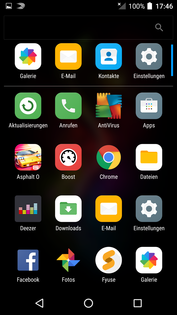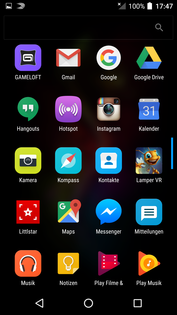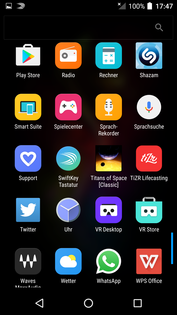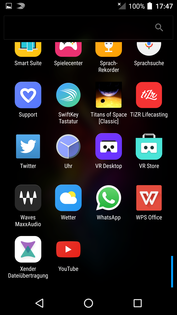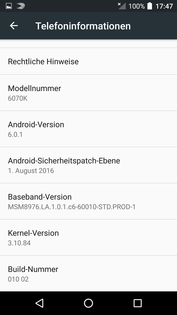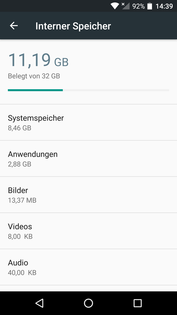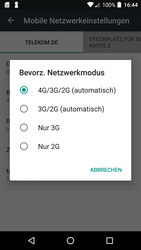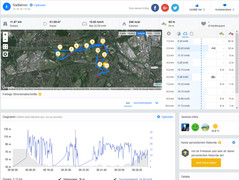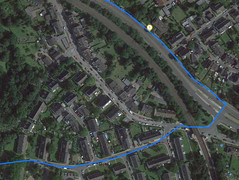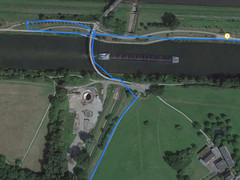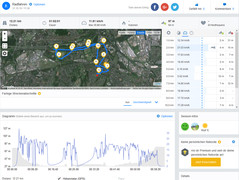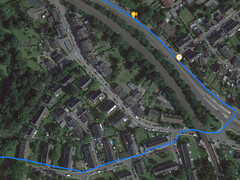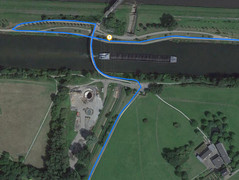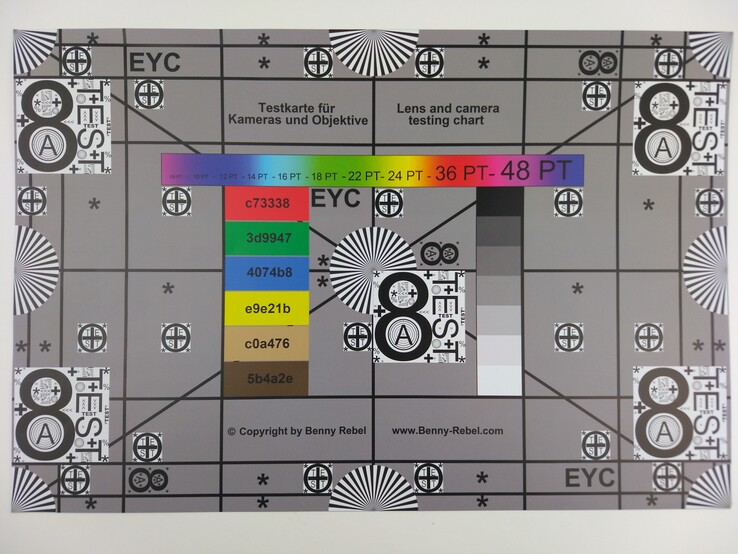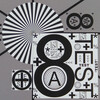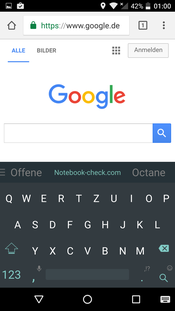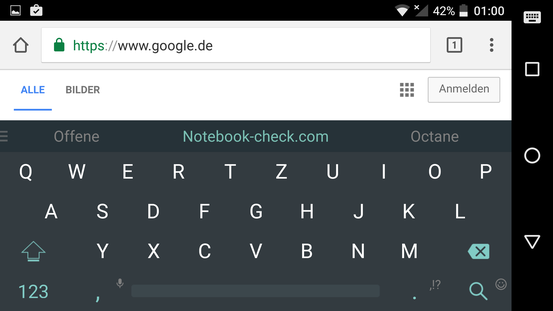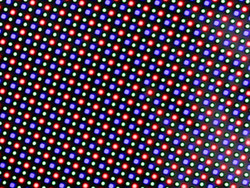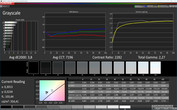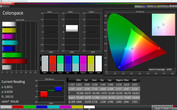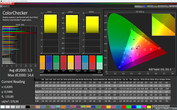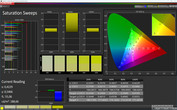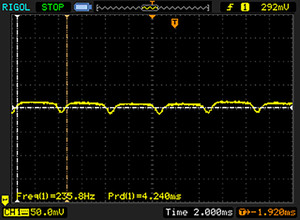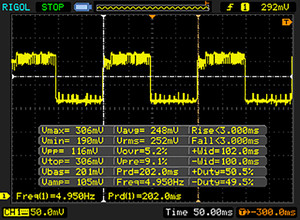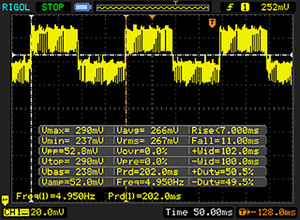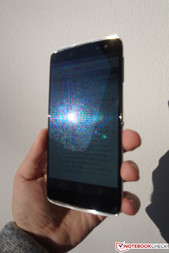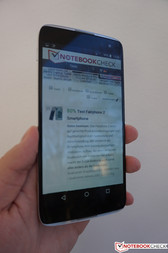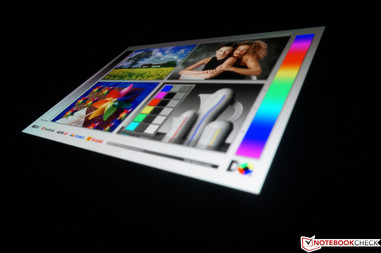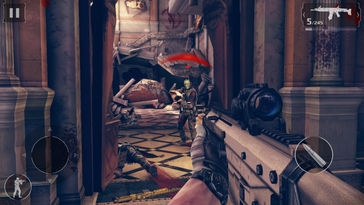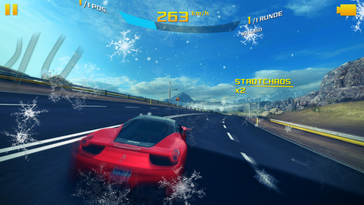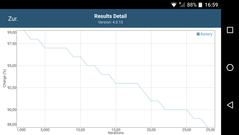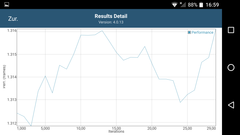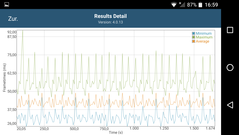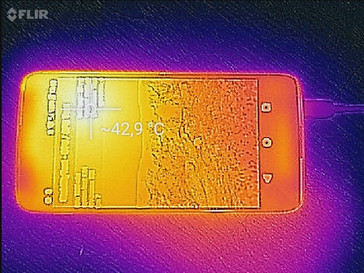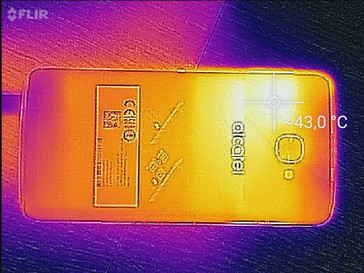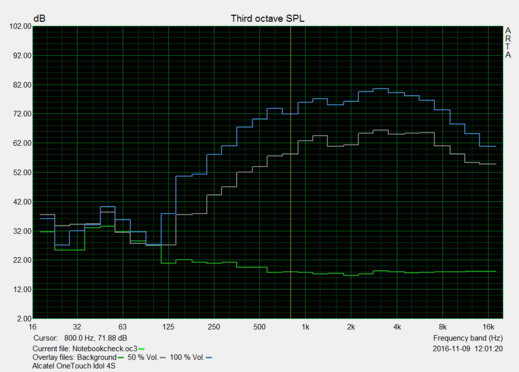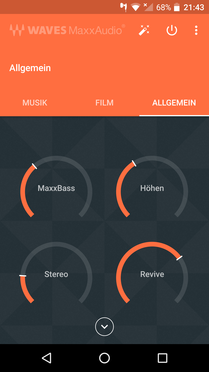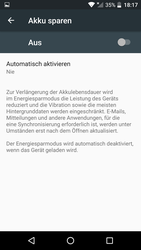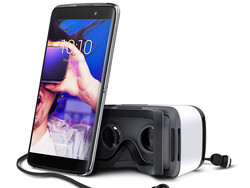Alcatel One Touch Idol 4S Smartphone Review

For the original German review, see here.
The Chinese manufacturer TLC wants its Alcatel One Touch Idol 4S to compete with other premium smartphones. However, this goal is not supposed to be realized with pure performance, but comprehensive features instead. This includes the box, for example, which is also a VR headset, as well as a decent headset from JBL. The performance of the 5.5-inch smartphone is on an (upper) mainstream level. Besides a Snapdragon 652 SoC from Qualcomm, users get 3 GB of RAM and 32 GB internal storage, which can be expanded via microSD.
Alcatel charges 449 Euros (RRP/~$474) for the Idol 4S, so it faces strong competitors such as the new OnePlus 3T, the Honor 8 or the ZTE Axon 7. All of them managed very good scores in our reviews. Another interesting comparison device is the more expensive Blackberry DTEK60, which is also made by TLC and basically uses an identical chassis.
Case
The case of the Alcatel One Touch Idol 4S is made of metal and glass. The metal frame becomes tapered towards the sides, so the two glass elements on the front and the rear look like "framed". The frame also stands out a little at the top and the bottom of the glass, which makes room for two front-facing speakers. There are three color options, but only the color of the metal frame differs. Besides our silver test unit, you can also get it in gold or dark gray. We have already mentioned that the chassis is basically identical to the more expensive BlackBerry DTEK60.
The Alcatel can easily keep up with the rivals in terms of quality. The stability is excellent, because neither pressure nor twisting attempts are a problem for the big smartphone. We cannot criticize the build quality either, and the well-integrated card slot on the left side is also made of metal. Only the volume rocker is rather wobbly. One visual drawback of the glass back is its sensitivity to dirt. You will quickly have a smudgy smartphone if you do not clean it regularly.
The Idol 4S is a rather large smartphone, even within our comparison group. This is a result of the previously mentioned "protruding" frame, but also the large bezels above and below the actual screen. It is the slimmest smartphone at 7 mm (~0.3 in), but you have to consider the small camera bump at the rear as well. It is also the lightest phablet here at around 150 grams (~5.3 oz).
Connectivity
Inside the One Touch Idol 4S is the Qualcomm Snapdragon 652 SoC with a total of eight cores and the Adreno 510 GPU, which is supported by 3 GB of RAM. The internal storage capacity is 32 GB, but you can only use around 20 GB after the update of all preloaded apps. The storage can be expanded via microSD (up to 200 GB) and the card can be formatted either as portable or internal storage.
The Micro-USB port at the bottom supports only the 2.0 standard and cannot transfer videos. However, it supports USB-OTG for easy connections with storage devices and peripherals. Connections can also be established via Wi-Fi Direct, Bluetooth 4.2, and NFC. An FM radio is also included.
Software
The operating system of the Idol 4S is Android 6.0.1 Marshmallow with security patches as of September 2016. According to initial information, an update to Android 7 Nougat was supposed to arrive by the end of the year, but this has not been the case so far. There are only small differences compared to standard Android, but there are some additional apps on the device (can be deleted if necessary).
The function bar on the lock screen is one handy feature, which gives direct access to the call history, timer or the settings, for instance. The smartphone can also be activated and even locked via a double tap on the screen. The navigation is very smooth in general. A notification LED is located above the display, but it cannot be configured.
Communication and GPS
We can find more drawbacks in the communication department, because the LTE module supports only Cat.4 (150 Mbps downstream, 50 Mbps upstream) and it does not cover many frequencies either (see specifications at the top for full list). However, we did not have any problems in the metropolitan T-Mobile network. LTE is supported by both Nano-SIM slots, but you will have to forgo the microSD when you use two SIMs.
The smartphone does support all common WLAN standards, including the fast 802.11ac, but the performance in our standardized WLAN test with the router Linksys EA8500 is really bad. Only 35 Mbps (send & receive) are easily beaten by the rivals. We cannot explain the results; maybe there are compatibility issues with the router. Subjectively, the performance was at least okay in combination with an AVM Fritz!Box 7490.
| Networking | |
| iperf3 transmit AX12 | |
| OnePlus 3T | |
| ZTE Axon 7 | |
| Alcatel One Touch Idol 4S | |
| iperf3 receive AX12 | |
| ZTE Axon 7 | |
| OnePlus 3T | |
| Alcatel One Touch Idol 4S | |
The smartphone can only locate the position via GPS (A-GPS). This was not possible indoors, but the position was quickly found outdoors (~15 seconds) and the result was very accurate at 3 meters (~10 ft). We also check the performance of the test model on a bicycle ride and compare the results with the professional navigation device Garmin Edge 500. The Idol 4S takes some smaller "shortcuts", and the overall track length is slightly shorter, but there should not be any problems in practice.
Telephone Functions and Voice Quality
The phone app is the standard Android app and is therefore easy to use. However, the quality of the calls is not very good. Voices generally sound very tinny and rather distorted on our side of the call. This is also confirmed by the recipient and there were even some dropouts. The problems continue when you use the hands-free function or the headset, so there is still room for improvements.
Cameras
An 8 MP camera with an 84° wide angle lens and an additional flash is sitting at the front. The flash helps in low-light situations, but unfortunately, the overall quality of the pictures is never really convincing. Colors appear quite pale and the details are never really sharp, even in good lighting conditions.
The main camera uses a 16 MP sensor. The colors are rather too saturated, but the results actually look pretty good in practice. However, we can once again notice blurry edges when we zoom in on the sample pictures and the test chart. The camera is good enough for snapshots in bright environments, but you cannot see much in low-light scenarios (scene 3).
Videos can be recorded in 4K (3840x2160 pixels, ~38 Mbps, 26 fps), but the default setting is Full HD (1920x1080 pixels, ~18 Mbps, 28 fps). 4K recordings are fortunately not darker compared to Full HD, but we would have liked to see a higher frame rate option for the latter.
Accessories and Warranty
We usually focus on the contents of the box in this section, but the box of the Idol 4S is actually a VR headset. Both the design and the quality are reminiscent of the Gear VR from Samsung, but there are some functional differences. Probably the biggest difference is the absence of a sharpness control. The headset is not compatible with glasses, so this can be a problem. The controls are also simplified, because there are only two buttons on the headset (select & back). The VR experience it suffers slightly from the limited field of view. Subjectively, the smartphone display is quite far away and you can clearly see the black edges from the goggles, so there is no immersive feeling.
Besides the usual accessories such as the power adapter (10 watts, modular), the USB cable and some service leaflets, we also get a decent headset from JBL, a protective phone case, and a screen protector.
The warranty period is 12 months. Please see our Guarantees, Return Policies & Warranties FAQ for country-specific information.
Input Devices and Handling
The handling of the Idol 4S is supposed to be improved by the Boom button on the right side. It can be assigned with several functions, but we had some issues in practice. Because of the position, you expect a power button or the camera trigger. We sometimes accidentally took a screenshot instead of a picture, for example. The Android controls are onscreen buttons, even though there would have been enough room for sensor buttons beneath the display.
The capacitive touchscreen recognizes up to 10 inputs simultaneously and is very precise, but also pretty sensitive. We sometimes triggered actions, even though we only scrolled through the menus. Alcatel has installed SwiftKey as well as the standard Android keyboard. It supports all common features, but you can also install another model from the Play Store.
Display
Alcatel uses a 5.5-inch AMOLED panel with the native resolution of 2560x1440 pixels, so the content is very sharp (534 PPI). Subjectively, we really like the picture and the measurement results of the test model are also good. The luminance is particularly impressive, because we can measure up to 627 nits on a pure white picture, and even up to 760 nits with an even distribution of bright and dark contents. It is therefore not surprising that the maximum luminance is only available via the brightness sensor; the manual control ends at 353 nits. These results are superior to the rivals.
The black value is 0.0 cd/m² because dark pixels are not illuminated, so the contrast ratio is infinite in theory. PWM flickering at all brightness levels is also typical for an AMOLED panel.
| |||||||||||||||||||||||||
Brightness Distribution: 92 %
Center on Battery: 625 cd/m²
Contrast: ∞:1 (Black: 0 cd/m²)
ΔE ColorChecker Calman: 5.9 | ∀{0.5-29.43 Ø4.78}
ΔE Greyscale Calman: 3.8 | ∀{0.09-98 Ø5}
Gamma: 2.27
CCT: 7196 K
| Alcatel One Touch Idol 4S AMOLED, 2560x1440, 5.5" | Honor 8 IPS, 1920x1080, 5.2" | ZTE Axon 7 AMOLED, 2560x1440, 5.5" | OnePlus 3T Optic-AMOLED, 1920x1080, 5.5" | BlackBerry DTEK60 AMOLED, 2560x1440, 5.5" | |
|---|---|---|---|---|---|
| Screen | -16% | -9% | -30% | -6% | |
| Brightness middle (cd/m²) | 625 | 451 -28% | 328 -48% | 421 -33% | 590 -6% |
| Brightness (cd/m²) | 639 | 443 -31% | 334 -48% | 430 -33% | 608 -5% |
| Brightness Distribution (%) | 92 | 93 1% | 88 -4% | 84 -9% | 88 -4% |
| Black Level * (cd/m²) | 0.4 | ||||
| Colorchecker dE 2000 * | 5.9 | 5.4 8% | 4.6 22% | 7.1 -20% | 6.6 -12% |
| Colorchecker dE 2000 max. * | 14.6 | 9.9 32% | 14.7 -1% | 15.3 -5% | 14.3 2% |
| Greyscale dE 2000 * | 3.8 | 6.7 -76% | 2.8 26% | 6.8 -79% | 4.3 -13% |
| Gamma | 2.27 97% | 2.33 94% | 2.29 96% | 2.23 99% | 1.88 117% |
| CCT | 7196 90% | 8262 79% | 6612 98% | 7866 83% | 6966 93% |
| Contrast (:1) | 1128 |
* ... smaller is better
You can adjust the color temperature in the settings and also select a natural mode, which will reduce the rich colors that are also typical for AMOLED panels. Our measurements determine decent results. The grayscale in particular is not far from the ideal value (<3) with an average DeltaE-2000 deviation of 3.8 compared to the sRGB reference color space. The colors show bigger deviations, especially red (14.6) and green (10), and the colors are too saturated in general.
Screen Flickering / PWM (Pulse-Width Modulation)
| Screen flickering / PWM detected | 235.8 Hz | ≤ 100 % brightness setting | |
The display backlight flickers at 235.8 Hz (worst case, e.g., utilizing PWM) Flickering detected at a brightness setting of 100 % and below. There should be no flickering or PWM above this brightness setting. The frequency of 235.8 Hz is relatively low, so sensitive users will likely notice flickering and experience eyestrain at the stated brightness setting and below. In comparison: 53 % of all tested devices do not use PWM to dim the display. If PWM was detected, an average of 8101 (minimum: 5 - maximum: 343500) Hz was measured. | |||
Display Response Times
| ↔ Response Time Black to White | ||
|---|---|---|
| 6 ms ... rise ↗ and fall ↘ combined | ↗ 3 ms rise | |
| ↘ 3 ms fall | ||
| The screen shows very fast response rates in our tests and should be very well suited for fast-paced gaming. In comparison, all tested devices range from 0.1 (minimum) to 240 (maximum) ms. » 17 % of all devices are better. This means that the measured response time is better than the average of all tested devices (20.2 ms). | ||
| ↔ Response Time 50% Grey to 80% Grey | ||
| 18 ms ... rise ↗ and fall ↘ combined | ↗ 7 ms rise | |
| ↘ 11 ms fall | ||
| The screen shows good response rates in our tests, but may be too slow for competitive gamers. In comparison, all tested devices range from 0.165 (minimum) to 636 (maximum) ms. » 31 % of all devices are better. This means that the measured response time is better than the average of all tested devices (31.6 ms). | ||
Thanks to the enormous luminance, it is no problem to use the One Touch Idol 4S in very bright environments. Only direct light sources should be avoided, since they can cause annoying reflections on the glossy screen. The AMOLED panel provides very wide viewing angles, but you can see the typical blue hue from some angles.
Performance
Alcatel dispensed with a modern high-end SoC and equipped the Idol 4S with the Snapdragon 652 from Qualcomm, which is still manufactured in a 28-nm process. It is certainly not slow with eight CPU cores (4x Cortex-A72 @1.8 GHz, 4x Cortex-A53 @1.4 GHz), but the competitors just have faster SoCs. This is also supported by our benchmarks, where the processor of the Idol 4S is usually at the bottom of the ranking.
Graphics calculations are handled by the Adreno 510 (550 MHz), which supports all features of the faster Adreno 530 (such as Vulkan & OpenGL ES 3.1). The performance of the GPU is slightly better than the previous high-end GPU Adreno 330. The graphics card is usually just beaten by the Mali-T880 MP4 in the Honor 8, but the Adreno 530 of the other two rivals OnePlus 3T and ZTE Axon 7 is much faster. The benchmark 3DMark Sling Shot 3.1 Unlimited crashed repeatedly.
| AnTuTu v6 - Total Score | |
| OnePlus 3T | |
| BlackBerry DTEK60 | |
| ZTE Axon 7 | |
| Honor 8 | |
| Alcatel One Touch Idol 4S | |
| BQ Aquaris X5 Plus | |
| Geekbench 4.0 | |
| 64 Bit Single-Core Score | |
| OnePlus 3T | |
| Honor 8 | |
| Alcatel One Touch Idol 4S | |
| ZTE Axon 7 | |
| BQ Aquaris X5 Plus | |
| BlackBerry DTEK60 | |
| 64 Bit Multi-Core Score | |
| Honor 8 | |
| OnePlus 3T | |
| ZTE Axon 7 | |
| Alcatel One Touch Idol 4S | |
| BQ Aquaris X5 Plus | |
| BlackBerry DTEK60 | |
| GFXBench (DX / GLBenchmark) 2.7 | |
| T-Rex Onscreen | |
| OnePlus 3T | |
| ZTE Axon 7 | |
| Honor 8 | |
| BQ Aquaris X5 Plus | |
| OnePlus One | |
| Alcatel One Touch Idol 4S | |
| BlackBerry DTEK60 | |
| 1920x1080 T-Rex Offscreen | |
| OnePlus 3T | |
| ZTE Axon 7 | |
| Honor 8 | |
| Alcatel One Touch Idol 4S | |
| BQ Aquaris X5 Plus | |
| OnePlus One | |
| BlackBerry DTEK60 | |
| GFXBench 3.0 | |
| on screen Manhattan Onscreen OGL | |
| OnePlus 3T | |
| ZTE Axon 7 | |
| Honor 8 | |
| BQ Aquaris X5 Plus | |
| OnePlus One | |
| Alcatel One Touch Idol 4S | |
| 1920x1080 1080p Manhattan Offscreen | |
| OnePlus 3T | |
| ZTE Axon 7 | |
| Honor 8 | |
| Alcatel One Touch Idol 4S | |
| BQ Aquaris X5 Plus | |
| OnePlus One | |
| GFXBench 3.1 | |
| on screen Manhattan ES 3.1 Onscreen | |
| OnePlus 3T | |
| ZTE Axon 7 | |
| Honor 8 | |
| BQ Aquaris X5 Plus | |
| Alcatel One Touch Idol 4S | |
| 1920x1080 Manhattan ES 3.1 Offscreen | |
| OnePlus 3T | |
| ZTE Axon 7 | |
| Honor 8 | |
| BQ Aquaris X5 Plus | |
| Alcatel One Touch Idol 4S | |
| PCMark for Android - Work performance score | |
| Honor 8 | |
| OnePlus 3T | |
| ZTE Axon 7 | |
| BQ Aquaris X5 Plus | |
| Alcatel One Touch Idol 4S | |
| BlackBerry DTEK60 | |
| OnePlus One | |
Alcatel has not installed its own browser and uses Google Chrome instead, in this case in version 54. The performance situation is better for the test model, because it can beat the ZTE Axon 7 in some tests. All four models are pretty close here in general and the subjective browsing experience is convenient.
| Octane V2 - Total Score | |
| Honor 8 | |
| OnePlus 3T | |
| BlackBerry DTEK60 | |
| Alcatel One Touch Idol 4S | |
| ZTE Axon 7 | |
| Mozilla Kraken 1.1 - Total | |
| Alcatel One Touch Idol 4S | |
| ZTE Axon 7 | |
| Honor 8 | |
| BlackBerry DTEK60 | |
| OnePlus 3T | |
| JetStream 1.1 - Total Score | |
| Honor 8 | |
| BlackBerry DTEK60 | |
| OnePlus 3T | |
| Alcatel One Touch Idol 4S | |
| ZTE Axon 7 | |
* ... smaller is better
The internal eMMC storage with a capacity of 32 GB falls behind the competition as well. The results are actually not bad, but the rivals are just faster, especially with small files.
We check the performance of the card reader with our reference card from Toshiba (Exceria Pro M401), which manages transfer rates of up to 95 and 80 MB/s (read/write) according to the manufacturer. Our tests determine decent results of 75 and 56 MB/s, so it is no problem to expand the storage capacity.
| Alcatel One Touch Idol 4S 32 GB eMMC Flash | Honor 8 32 GB eMMC Flash | ZTE Axon 7 64 GB eMMC Flash | OnePlus 3T 64 GB UFS 2.0 Flash | BlackBerry DTEK60 32 GB eMMC Flash | |
|---|---|---|---|---|---|
| AndroBench 3-5 | 14% | 67% | 212% | 7% | |
| Sequential Write 256KB SDCard (MB/s) | 56.3 | 23.59 -58% | 51.3 -9% | 58.5 4% | |
| Sequential Read 256KB SDCard (MB/s) | 74.6 | 53.7 -28% | 78.4 5% | 78.8 6% | |
| Random Write 4KB (MB/s) | 14.45 | 31.5 118% | 16.22 12% | 74.4 415% | 15.1 4% |
| Random Read 4KB (MB/s) | 36.53 | 34.16 -6% | 121.1 232% | 123.6 238% | 43.1 18% |
| Sequential Write 256KB (MB/s) | 80.8 | 119.3 48% | 150.9 87% | 165.3 105% | 79 -2% |
| Sequential Read 256KB (MB/s) | 231.9 | 247.5 7% | 406.5 75% | 436.4 88% | 257.4 11% |
Games
We have already mentioned that the Adreno 510 supports modern APIs such as Vulkan 1.0 and OpenGL ES 3.1. The performance of the GPU sometimes struggles with very demanding titles due to the high native display resolution. One example is “Asphalt 8: Airborne”, which is not completely smooth on high details. Gaming is still a good experience on the Idol 4S, which is a result of the precise controls and the two front-facing stereo speakers in particular.
Emissions
Temperature
The upper part of the smartphone warms up quite a bit under load. It is not uncomfortable, but up to 42 °C (~108 °F) is definitely perceptible, especially when you play games. The high temperatures are also a result of the steady SoC performance, because we cannot determine any throttling under sustained load with the GFXBench Battery Test.
(±) The maximum temperature on the upper side is 42.1 °C / 108 F, compared to the average of 35.2 °C / 95 F, ranging from 21.9 to 247 °C for the class Smartphone.
(+) The bottom heats up to a maximum of 39.8 °C / 104 F, compared to the average of 34 °C / 93 F
(+) In idle usage, the average temperature for the upper side is 26.5 °C / 80 F, compared to the device average of 32.9 °C / 91 F.
Speakers
The two speakers at the front (2x 3.6 watts) can be very loud at almost 89 dB(A) and create a very good sound for a smartphone. Bass is not available due to the construction, but the sound is otherwise pretty rich and there is even a certain stereo effect. The software Waves AudioMaxx can improve the sound with different profiles when you attach headphones. The provided headset from JBL also leaves a pretty good impression, but the small modules sit very deep in the ear canal, which is probably not ideal for all users.
Alcatel One Touch Idol 4S audio analysis
(+) | speakers can play relatively loud (88.9 dB)
Bass 100 - 315 Hz
(-) | nearly no bass - on average 25.6% lower than median
(±) | linearity of bass is average (11.5% delta to prev. frequency)
Mids 400 - 2000 Hz
(+) | balanced mids - only 2.7% away from median
(+) | mids are linear (5.2% delta to prev. frequency)
Highs 2 - 16 kHz
(+) | balanced highs - only 4.7% away from median
(+) | highs are linear (4.3% delta to prev. frequency)
Overall 100 - 16.000 Hz
(±) | linearity of overall sound is average (18% difference to median)
Compared to same class
» 16% of all tested devices in this class were better, 8% similar, 76% worse
» The best had a delta of 11%, average was 35%, worst was 134%
Compared to all devices tested
» 37% of all tested devices were better, 8% similar, 55% worse
» The best had a delta of 4%, average was 24%, worst was 134%
OnePlus 3T audio analysis
(+) | speakers can play relatively loud (84.3 dB)
Bass 100 - 315 Hz
(-) | nearly no bass - on average 24.6% lower than median
(±) | linearity of bass is average (7.2% delta to prev. frequency)
Mids 400 - 2000 Hz
(+) | balanced mids - only 4.6% away from median
(+) | mids are linear (4.6% delta to prev. frequency)
Highs 2 - 16 kHz
(±) | higher highs - on average 7.1% higher than median
(+) | highs are linear (2.8% delta to prev. frequency)
Overall 100 - 16.000 Hz
(±) | linearity of overall sound is average (20.9% difference to median)
Compared to same class
» 38% of all tested devices in this class were better, 8% similar, 54% worse
» The best had a delta of 11%, average was 35%, worst was 134%
Compared to all devices tested
» 56% of all tested devices were better, 8% similar, 36% worse
» The best had a delta of 4%, average was 24%, worst was 134%
Frequency Comparison (Checkboxes select/deselectable!)
Energy Management
Power Consumption
Our consumption measurements show very low values for the Alcatel One Touch 4S. The idle and average load results in particular, are good. Only maximum load will result in little more than 10 watts, so the provided 10-watt PSU is sufficient, but does not have a lot of headroom to charge the battery under load.
| Off / Standby | |
| Idle | |
| Load |
|
Key:
min: | |
| Alcatel One Touch Idol 4S 3000 mAh | Honor 8 3000 mAh | ZTE Axon 7 3250 mAh | OnePlus 3T 3400 mAh | BlackBerry DTEK60 3000 mAh | |
|---|---|---|---|---|---|
| Power Consumption | -31% | 3% | -37% | -12% | |
| Idle Minimum * (Watt) | 0.76 | 0.78 -3% | 0.64 16% | 0.61 20% | 0.7 8% |
| Idle Average * (Watt) | 1.02 | 1.89 -85% | 0.84 18% | 1.77 -74% | 1.13 -11% |
| Idle Maximum * (Watt) | 1.04 | 2.02 -94% | 0.87 16% | 1.81 -74% | 1.2 -15% |
| Load Average * (Watt) | 4.4 | 5.28 -20% | 6.02 -37% | 6.67 -52% | 6.52 -48% |
| Load Maximum * (Watt) | 10.4 | 5.44 48% | 10.45 -0% | 10.98 -6% | 9.75 6% |
* ... smaller is better
Battery Runtime
The battery of the One Touch Idol 4S is one of the smallest within the comparison group with a capacity of 3000 mAh. Thanks to the decent consumption values, the runtimes should still be sufficient in practice. We check that with our WLAN script, which visits different websites. The luminance is adjusted to 150 nits, so the results are comparable.
The runtime of almost 7 hours is on par with the ZTE Axon 7, but both the Honor 8 as well as the OnePlus 3T last more than an hour longer. We usually had no problems to manage a full business day during our review period. A power-saver mode is also available and can automatically be activated when the battery capacity drops to 15 or 5%. A full battery charge takes about 1:45 hours, but 50% are already available after 30 minutes.
| Alcatel One Touch Idol 4S 3000 mAh | Honor 8 3000 mAh | ZTE Axon 7 3250 mAh | OnePlus 3T 3400 mAh | BlackBerry DTEK60 3000 mAh | |
|---|---|---|---|---|---|
| Battery runtime | |||||
| WiFi v1.3 (h) | 6.9 | 8.3 20% | 6.9 0% | 8.2 19% | 13 88% |
Pros
Cons
Verdict
Can the Alcatel One Touch Idol 4S compete with the rivals? Not quite. The smartphone can actually justify its price with the stylish chassis, the good display, and the comprehensive accessories, but the competitors have fewer drawbacks. The Idol 4S suffers slightly from the mediocre voice quality, the bad front camera and the comparatively bad results in the performance and runtime tests.
A good mainstream smartphone with a great chassis and bright display, but the competition is just slightly better.
The VR headset is more of a nice gimmick, and the functionality is limited compared to Samsung's Gear VR. The advertised Boom button cannot really convince us in practice either. Alcatel's One Touch Idol 4S is not a bad choice, but there are better devices in the price segment of up to 450 Euros (~$475).
Alcatel One Touch Idol 4S
- 12/29/2016 v6 (old)
Andreas Osthoff




